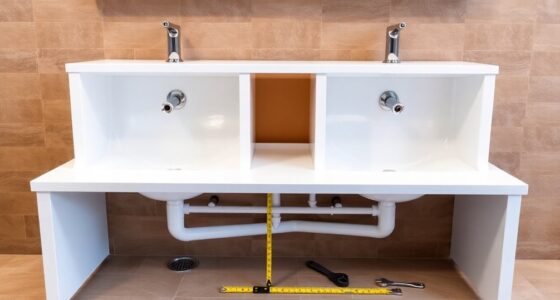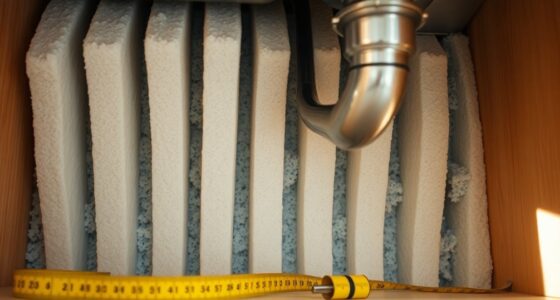To measure your sink drain size, start with a tape measure and check the diameter of the sink opening at its widest point. Most bathroom sinks have a hole diameter of about 1-½ inches. Next, measure the drain pipe diameter, typically 1 ¼ inches for bathrooms. Don't forget to check for overflow features to guarantee compatibility with your plumbing. Accurate measurements prevent leaks and blockages, and you'll find more important details ahead.
Key Takeaways
- Use a tape measure to accurately measure the diameter of the sink's drain opening at the threaded portion.
- Standard bathroom sink drain hole diameter is typically 1-½ inches; check manufacturer specifications for exact sizes.
- Measure the drain pipe beneath the sink, focusing on the widest part for accurate diameter, usually 1 ¼ to 2 inches.
- Record all measurements in inches and verify compatibility with overflow features to ensure effective drainage.
- Double-check measurements and review manufacturer instructions to confirm readiness for installation and avoid leaks.
Understanding Sink Drain Sizes
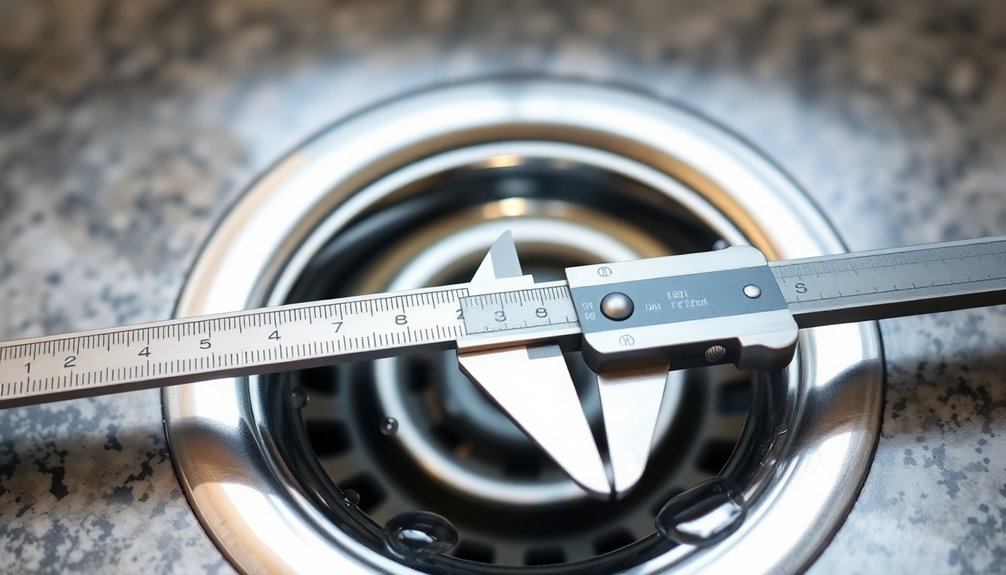
When measuring sink drain sizes, it's important to understand the standard dimensions to guarantee a proper fit.
The typical bathroom sink drain hole diameter is 1-½ inches, while you'll often find drain pipe sizes of 1 ¼ inches for bathroom sinks and 1 ½ inches for kitchens. If you have a double sink, you might need pipes up to 2 inches.
To make sure you select the correct sink drains, measure the diameter accurately at the threaded portion.
Keep in mind that sinks with overflow features need compatible drains, so matching the drain type to your sink is essential.
Always consult local plumbing codes and manufacturer recommendations to avoid any plumbing issues down the line.
Tools Needed for Measuring
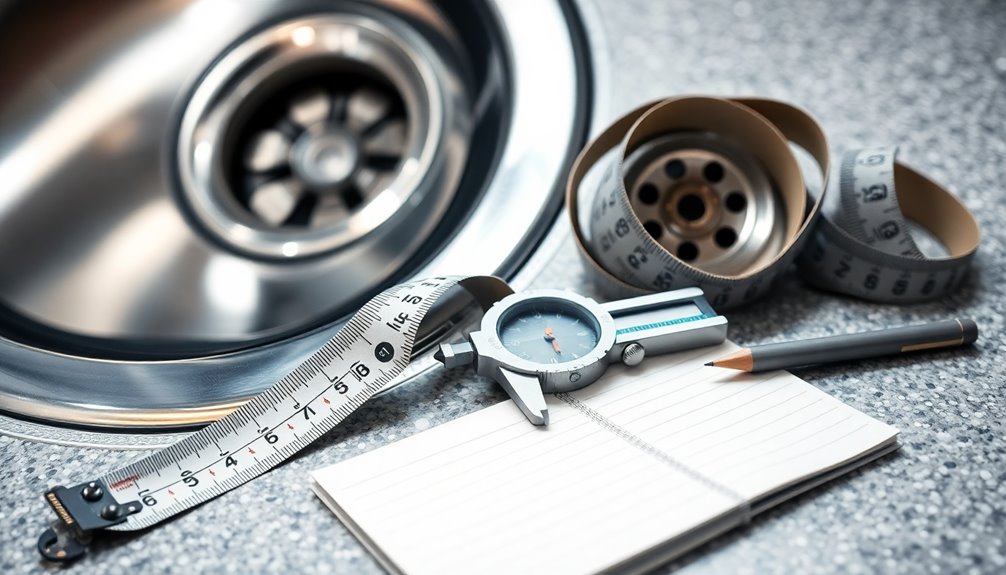
To measure sink drain size accurately, you'll need a few essential tools. A tape measure or ruler is vital for determining the diameter of both the drain opening and the threaded portion.
Make certain you're measuring at the widest part of the drain to confirm an accurate reading. Standard bathroom sink drain sizes typically range from 1 ¼ inches to 1 ½ inches in diameter, so record your measurements in inches.
It's also helpful to have a pen and paper handy to jot down these measurements for reference when selecting a new drain. If you encounter any difficulties, don't hesitate to consult professionals for assistance to assure precision in your measurements.
Measuring the Sink Opening

Measuring the sink opening is essential for finding the right drain.
Use a tape measure to check the diameter at the threaded portion, ensuring you get the widest point for accuracy.
Don't forget to compare your measurements with the manufacturer's specifications to guarantee a proper fit.
Determine Drain Opening Diameter
How can you guarantee your new drain fits perfectly? Start by accurately measuring the drain opening diameter of your sink.
Here's how to make sure you get it right:
- Use a tape measure to find the widest part of the sink drain opening.
- Note that the standard bathroom sink hole diameter is around 1-½ inches, which is ideal for most lavatory drains.
- Always check the manufacturer's instructions for any specific recommended drain size to make certain of compatibility.
Measure at Threaded Portion
While measuring the sink drain size, focus on the threaded portion, as it's the standard area for ensuring a proper fit. Use a tape measure to determine the diameter here, which typically measures 1 ¼ inches or 1 ½ inches for bathroom sinks. Accurate measurement at the threaded portion guarantees compatibility with the drain assembly and helps avoid installation issues. If your sink features an overflow, choose a drain that accommodates this, as it requires specific sizing and design.
Here's a quick reference table to help you:
| Measurement | Common Sizes | Notes |
|---|---|---|
| Threaded Portion | 1 ¼ inches | Standard for sinks |
| 1 ½ inches | Standard for sinks | |
| Overflow Feature | Specific design | Requires accurate sizing |
Check Manufacturer Specifications
Before you begin measuring the sink opening, it's important to check the manufacturer's specifications for drain compatibility. This step guarantees you select the correct drain size for peak performance.
Here's what to look for:
- Diameter: Common sizes for sink openings are 1 ¼ inches, 1 ½ inches, and 1 5/8 inches.
- Recommended Drain: Verify the manufacturer's recommended drain sizes to avoid mismatches.
- Accurate Measurements: Record the dimensions of both the sink opening and the threaded portion to confirm a perfect fit.
Measuring the Drain Pipe
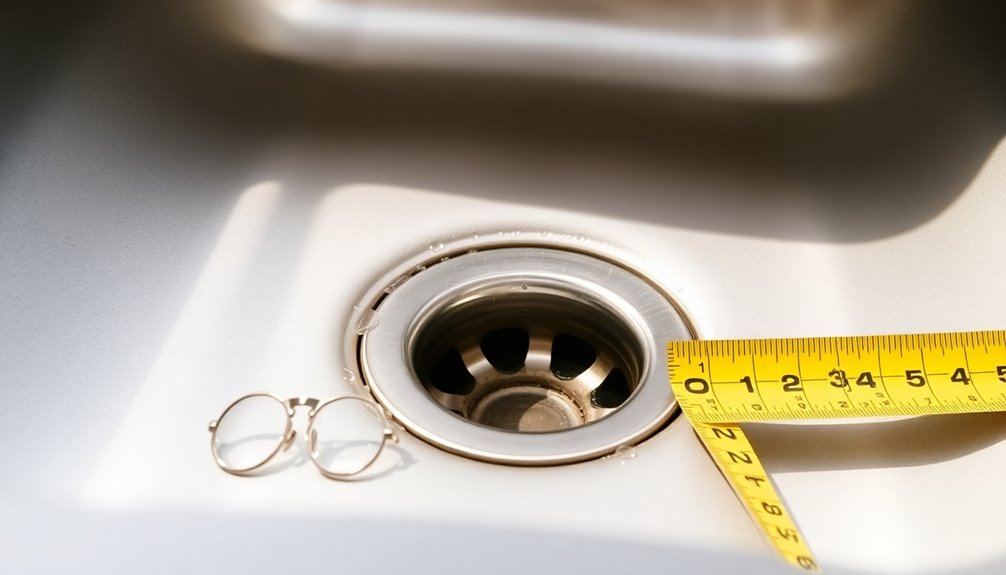
To accurately measure the sink drain pipe size, start by locating the drain pipe directly beneath your sink.
Use a tape measure to determine the diameter at the widest part of the pipe. Focus on the threaded portion, as this is critical for compatibility with drains.
Common bathroom sink drain pipe sizes include 1 ¼ inches, 1 ½ inches, and 2 inches, with 1 ¼ inches being the most typical.
Always compare your measurement against standard sizes to guarantee you get the correct size, as incorrect sizing can lead to plumbing problems.
Additionally, consult the manufacturer's instructions for specific recommendations on drain pipe sizes to comply with local plumbing codes and achieve peak performance.
Determining Overflow Features
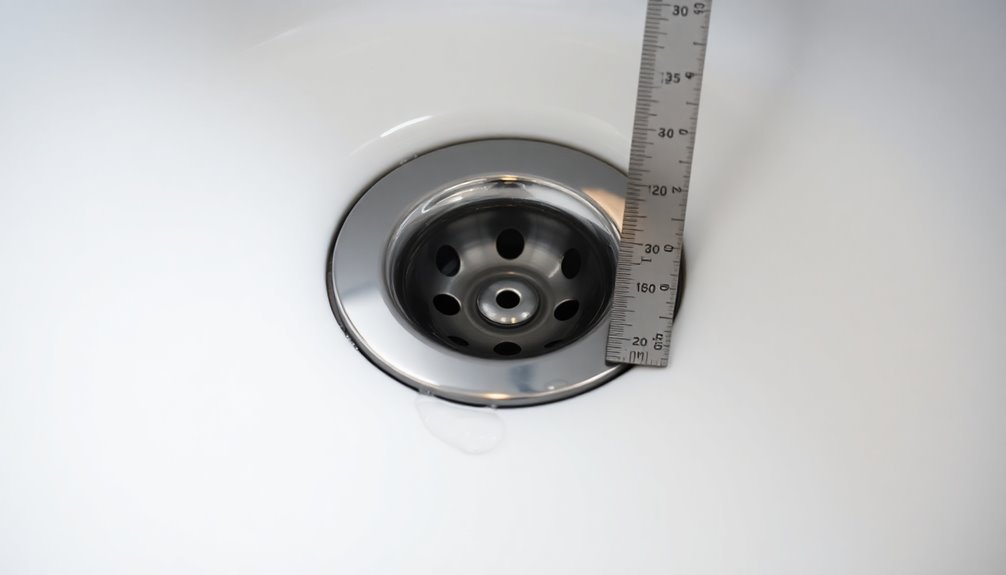
When evaluating your sink, check for an overflow opening, which helps prevent spills and enhances safety.
It's vital to match your sink with the right drain type—one with an overflow if your sink has that feature.
Always follow the manufacturer's guidelines to guarantee everything works properly.
Importance of Overflow Openings
Understanding the importance of overflow openings is essential for anyone selecting a sink. These features help prevent water from spilling over the edge, which is vital in busy areas like bathrooms.
Properly matching your sink and drain is key to effective drainage systems and avoiding plumbing issues.
Here are three reasons to take into account overflow openings:
- Safety: They help prevent accidental overflow, protecting your bathroom.
- Functionality: Sinks with overflow openings require compatible bathroom sink drains to work efficiently.
- Maintenance: Correctly paired drains minimize the risk of clogs and slow drainage, ensuring peak performance.
Matching Drain Types
Choosing the right drain type for your sink isn't just about aesthetics; it directly impacts your sink's functionality. If your sink has overflow openings, you'll need to choose a drain that accommodates them. Conversely, if there's no overflow feature, opt for a drain without those openings.
Here's a quick reference to help you:
| Sink Type | Required Drain Type |
|---|---|
| With Overflow | Drain with Overflow Openings |
| Without Overflow | Drain without Overflow Openings |
| Standard Size | 1-½ inch diameter |
| Compatibility | Match with drain pipes |
Always consult manufacturer specifications to verify compatibility with your sink's overflow features, as this is essential for peak performance and preventing spills.
Safety Considerations for Overflow
Determining whether your sink has an overflow feature is essential for guaranteeing safe and effective drainage. An overflow hole helps prevent spills and water damage, particularly in bathroom sinks.
Here are some safety considerations to keep in mind:
- Check for the Overflow Hole: Look for a small hole near the top of the sink bowl.
- Choose a Compatible Drain: Confirm your drain is designed with an overflow feature if your sink has one.
- Follow Manufacturer's Specifications: Always refer to the manufacturer's guidelines to select the right drain type based on the presence or absence of an overflow feature.
Ensuring Compatibility With Existing Plumbing
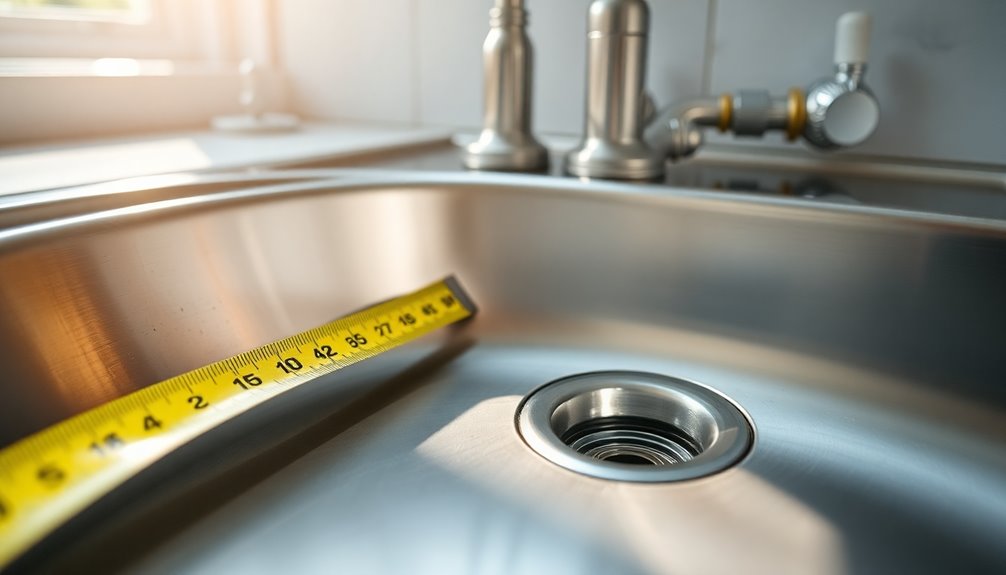
When you're ready to install a new sink drain, guaranteeing it fits with your existing plumbing is essential for proper functionality.
Start by measuring the diameter of the sink drain opening at the threaded portion. Most bathroom sinks typically require a kitchen sink drain size of either 1 ¼ inches or 1 ½ inches.
If your sink has an overflow, pick a drain with an overflow opening to maintain proper drainage. Local plumbing codes may dictate the size of the drain pipe you need, so check those as well.
Finally, consult manufacturer specifications to guarantee your chosen drain type aligns with your plumbing system. This will help prevent drainage issues and enhance water flow for your sink.
Tips for Accurate Measurements
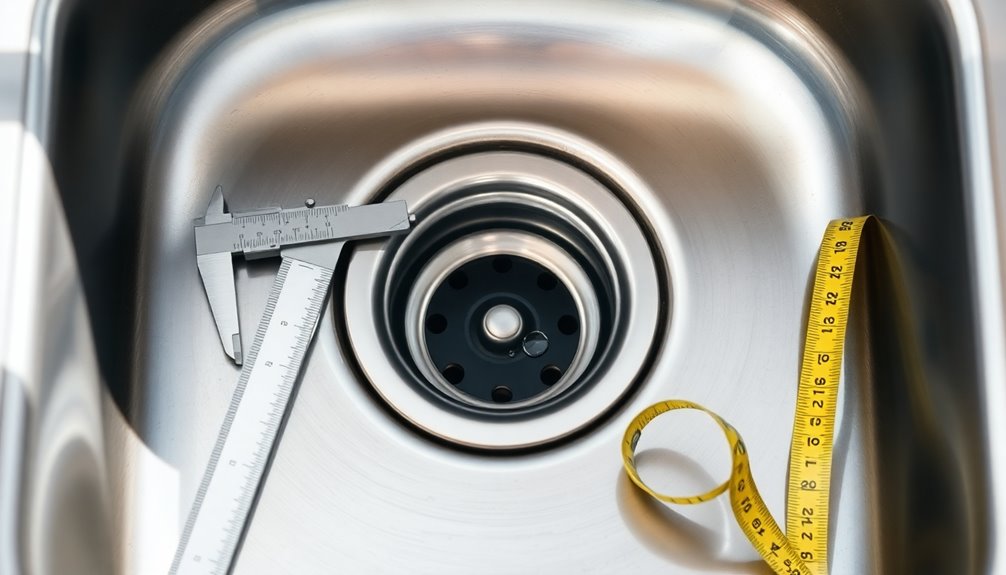
To guarantee you get the right fit for your sink drain, start by using a tape measure to accurately gauge the diameter of the sink drain at the threaded portion. This guarantees your measurements are precise for the sink drain pipe.
- Measure the diameter of the sink opening and the threaded portion to confirm compatibility with your chosen drain.
- Remember that the standard bathroom sink hole diameter is typically 1-½ inches; check your measurements against this size.
- Always consult manufacturer instructions for recommended drain sizes specific to your sink model.
Double-check your measurements to account for any irregularities, guaranteeing the drain fits correctly to prevent water leaks or blockages.
Frequently Asked Questions
How Do I Know What Size Sink Drain I Need?
To know what size sink drain you need, start by measuring the diameter of the drain opening in your sink.
Compare your measurement with common sizes like 1 ¼ inches, 1 ½ inches, and 1 5/8 inches.
If your sink has an overflow feature, make certain you choose a drain that accommodates it.
Also, check the manufacturer's specifications to verify you're picking the right type for your sink's design and functionality.
How Do You Measure the Size of a Drain?
To measure the size of a drain, grab a tape measure and locate the widest part of the drain pipe.
Wrap the tape around the threaded portion and note the diameter. You'll typically find sizes like 1 ¼ inches or 1 ½ inches.
Don't forget to record your measurement right away to avoid confusion.
If you're unsure, you might want to consult a professional for accurate sizing and compatibility with your plumbing.
How to Know What Size Sink Strainer?
Picture your sink, water swirling down a shiny drain. To find the right sink strainer size, you'll need to measure the drain's diameter—usually about 1-½ inches for standard sinks.
Check the threaded part for accuracy. If your sink has an overflow, consider a strainer with an opening for that feature.
Finally, think about whether you prefer a pop-up or grid strainer, as each serves different needs. Always consult the manufacturer's guidelines!
How to Measure Sink Drain Stopper?
To measure your sink drain stopper, start by removing it from the sink.
Then, grab a tape measure and measure the diameter of the drain opening at the threaded part, usually around 1 ¼ inches or 1 ½ inches for standard bathroom sinks.
If your stopper has a mechanism, like a pop-up, measure its height and width too.
Don't forget to check for an overflow feature if that's relevant to your sink!
Conclusion
In your quest for the perfect sink drain size, precision is key. By measuring meticulously, you guarantee seamless synergy with your plumbing. Remember, a well-fitted drain keeps water flowing freely, preventing pesky problems down the line. So, gather your tools, take those thoughtful measurements, and transform your space with confidence. With careful consideration and a bit of creativity, you'll create an enchanting, cohesive look that enhances your home's harmony. Happy measuring!


